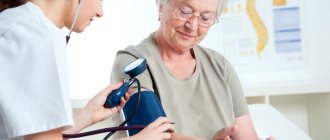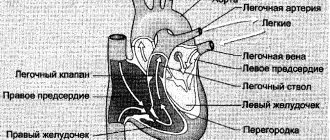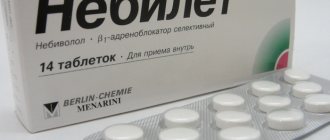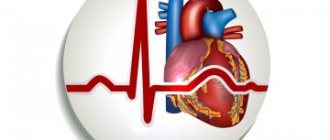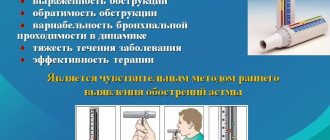Throughout a person's life, blood pressure changes several times.
The changes that occur to a person are enormous, especially during adolescence, when the body prepares for adulthood.
Blood pressure in adolescents is influenced not only by stress on the nervous system, but also by many other factors.
Table of normal blood pressure values for young people
Adolescence is the peak of hormonal changes in a child’s body, which present surprise after surprise. A surge of emotions, hormones, endless stress, sleepless nights at the computer - everything provokes pressure surges. Moreover, both upward and vice versa.
In medicine, the average value is taken as the norm. For teenagers it is calculated using a special formula
- systolic: (1.7 x adolescent age) + 83
- diastolic: (1.6 x adolescent age) + 42
For example, a teenager is 15 years old, which means his systolic indicator is: 1.7x15+83 = 108.5. Diastolic: 1.6x15+42 = 66. That is, for this teenager the normal blood pressure = 109/66 units.
The figures for normal blood pressure in adolescents are presented in the table
| Age | Normal blood pressure indicators in mmHg. Art. | ||
| Minimum | Average | Maximum | |
| 12 years | 90/60 | 100/65 | 125/82 |
| 13 years | 92/62 | 105/63 | 130/84 |
| 14 years | 95/63 | 107/64 | 132/85 |
| 15 years | 97/65 | 109/66 | 136/86 |
| 16 years | 100/66 | 110/68 | 138/88 |
| 17 years | 105/68 | 112/70 | 140/90 |
Normal blood pressure for a 14-year-old teenager (107/64) corresponds to a pulse from 70 to 130 beats/minute. In girls, with the onset of menstruation, the pressure drops by 5-15 units, compared to boys. This is a physiological norm. In this case, the pulse difference between systolic (cardiac) and diastolic (renal) pressure should be 30-40 units, maximum 50. Indicators of the cardiovascular system depend on the constitution of the teenager.
Normal blood pressure in a 15-16 year old teenager (109/66) is accompanied by a pulse of 65 to 120 beats/minute. By the age of 17, the normal heart rate is from 60 to 110 beats/minute.
After puberty ends, problems with blood pressure remain behind, but still, if the fluctuations were significant, consultation with a specialist is necessary.
How to measure a child's blood pressure
To get a reliable blood pressure reading, follow the rules:
- The child’s condition at the time of measurement should be calm. Doctors recommend measuring the indicator in the morning, when he has just woken up, but has not yet gotten up;
- For comparison, data obtained in the same position is suitable - lying, sitting;
- Before starting the procedure, adjust the tonometer cuff. It is advisable to purchase a special one for measuring blood pressure for children;
- find out what blood pressure children of a certain age should have, so as not to mistakenly equate the indicators with adults.
The full development of children and future life depend on normal blood pressure. If treatment is not provided in a timely manner, it can lead to serious problems in adulthood. The inability to stay indoors for a long time and memory deterioration will not allow the child to get a profession that involves concentrating or working in an office.
Why does blood pressure fluctuate: deviations from the norm?
According to statistics, about 80% of teenagers complain to their families about being overworked and very tired. If we add hormonal surges, first love, quarrels in a team, misunderstanding between parents and children, physical inactivity, computer, TV, participation in sports competitions, then arterial problems will be obvious.
During this period, it is extremely important not to miss the debut of serious pathologies, the symptom of which can only be a rise or fall in blood pressure.
Increased
High blood pressure is recorded in 10% of cases. There are many causes of teenage hypertension. First of all, these are external factors that cause disturbances in the psycho-emotional state of every third person.
For example, during tonometry, the pulse quickens and the pressure increases from the moment the cuff is put on the forearm. This is manipulative hypertension.
Hormonal surges are another provocateur of hypertension. Adrenaline (stress) rise in blood pressure is the norm at 10-12 years old in girls and at 13-14 years old in boys.
The main reason is hormonal changes in the body with high levels of aldosterone and adrenaline. These hormones spasm blood vessels, causing a reflex rise in blood pressure. In this case, there are no symptoms; high blood pressure is detected by chance. This is all primary hypertension, the elimination of the causes of which normalizes blood pressure. If the upper level indicators remain above 135 units, a full examination of the teenager is needed.
It is much more serious if secondary hypertension is a symptom of some disease:
- diabetes;
- kidney pathology;
- disturbances in the functioning of the heart and blood vessels;
- obesity and other endocrine disorders;
- brain damage;
- poisoning of various origins, toxic infections;
- VSD is the most dangerous diagnosis, which is a prerequisite for hypertension in adults.
The danger is that such hypertension is easy to miss, and it is the first sign of a latent pathology. Parents should be alert to the following symptoms:
- constant dizziness, migraine;
- mood swings, irritability;
- weakness, fatigue;
- nosebleeds;
- poor sleep;
- nausea.
If there is at least one symptom, you need to show the teenager to a doctor in time.
Low
Hypotension may be a physiological norm for a teenager. This occurs after increased physical activity, prolonged exposure to a stuffy room, or a heavy dinner and goes away with the elimination of the cause.
Sometimes hypotension occurs periodically; it is provoked by:
- prolonged stress;
- endocrine disorders (deficiency of pituitary hormones);
- infections of various etiologies;
- bleeding;
- heart defects;
- head injuries, including birth injuries;
- anemia;
- avitaminosis;
- intoxication;
- allergy;
- physical inactivity.
Most often there is a combination of provoking factors. Hypotonic teenagers complain of:
- pressing headache;
- chronic fatigue, apathy;
- sweating;
- irritability, tearfulness;
- discomfort behind the sternum.
The symptoms are nonspecific, so it is difficult to suspect problems with blood pressure. But this is very important, since treatment at this stage requires quite serious treatment.
Factors affecting blood pressure readings
The indicators determine the speed of blood flow. The supply of oxygen to internal organs and tissues depends on blood flow. Arterial values are influenced by:
- age - indicators increase every year, and in teenagers sharp jumps are most often observed;
- gender - adolescent boys have lower values than girls of the same age;
- obesity - the higher the deviation from the norm in weight, the more the pressure jumps;
- bad habits - smoking, alcohol abuse, unhealthy diet, irregular sleep lead to disorders;
- sports - excessive physical activity leads to deviations in indicators up or down.
Various factors can influence blood pressure
Diagnostics
The main diagnostic method is tonometry: regular, several times a day. Adolescence is one of the stages of growing up, so symptoms that often arise are attributed to hormonal changes. However, a recorded increase or decrease in blood pressure at least three times in a row should make parents think, seek advice from a pediatrician, and conduct a full examination of the teenager, the algorithm of which is standard:
- history taking, physical examination;
- UAC, OAM:
- biochemical blood testing for all indicators prescribed by a specialist;
- ECG;
- Ultrasound.
The point is to establish the root cause of blood pressure fluctuations. If necessary, the doctor may order additional tests to clarify the diagnosis.
Change in indicators at 7-8 years
For children at this age, “jumps” in blood pressure are more often associated with increased psychological stress and high loads. Mostly they complain about feeling unwell after school, attending a club or section. According to medical statistics, in children seven years of age and older who study in specialized schools (mathematics, language, physics and mathematics), hypertension is diagnosed five times more often, and the blood pressure norm according to the table does not correspond. Such indicators are associated with high loads and insufficient rest.
Features of treatment
If deviations from the norm are identified, it is necessary to eliminate all provoking factors: balance the diet, lose excess weight, and add regular exercise.
To lower blood pressure, an atherogenic nutritional profile is required, in which foods are selected in such a way as to reduce the progression of the disease and restore normal metabolism, including lipid metabolism. These are seafood, lean fish, meat, nuts, citrus fruits.
In addition, salt intake is limited to 5 g. The teenager is advised to swim and walk. These simple measures can reduce blood pressure by 5-8 units. In this case, you need to regularly monitor your blood pressure, recording your readings daily.
Traditional recipes, agreed upon with a doctor, require stabilization of arterial parameters. They recommend tea made from rosehip, barberry, and calendula. Freshly squeezed juices of carrots, beets (be sure to dilute with water), lingonberries. Ready-made pharmacy tinctures of hawthorn, motherwort, valerian. For teenagers with discomfort in the heart area, compresses with mustard or apple cider vinegar are applied to the chest.
Only if high blood pressure is resistant to general health measures, herbs, and a balanced diet, the child is treated with medications. The general principles of therapy are as follows:
- use long-acting metabolic antihypertensive drugs;
- the choice of starting agents is dictated by the cause of hypertension;
- the complex necessarily involves ACE inhibitors (angiotensin-converting enzyme inhibitors), they act on the renin-angiotensin system, which secretes angiotensin II, known as one of the most effective hypertensive agents;
- impaired renal function dictates the use of drugs excreted by the liver;
- they begin treatment with minimal doses, and if there is no result, they begin to combine drugs;
- be sure to combine antihypertensive therapy with the prescription of correctors of lipid, carbohydrate, purine metabolism, and antiplatelet agents in order to normalize microcirculation;
- long-term therapy.
Treatment is carried out under the supervision of a doctor. Apply:
- ACE inhibitors (ACE inhibitors): Fosinopril, Spirapril, Omapatrilat;
- calcium channel blockers: Lercanidipine, Nifedipine, Nimodipine;
- beta blockers: Betaxolol, Carteolol, Labetalol;
- diuretics: Hypothiazide, Veroshpiron, Triampur, Spironolactone;
- sedatives: Novopassit, Afobazol, Elenium.
Sympatholytics, adrenergic blockers, and direct vasodilators are currently not relevant in the treatment of hypertension in adolescents. Each class of medications has its own advantages and contraindications. The choice of drug is made taking into account the cause of hypertension, blood pressure, the patient’s age, and concomitant diseases.
Hypotension is a different story: there is no talk of any traditional treatment. If decoctions and dietary supplements are prescribed, then only from a pharmacy, with a doctor’s prescription. Alcohol tinctures of eleutherococcus, lemongrass, ginseng, echinacea or immortelle. The dosage is of great importance here, so making your own is excluded. In the first place is changing the teenager’s lifestyle.
Normalization of the microclimate in the family, school, and sports team relieves teenage hypotension very well. The correct daily routine, good, sound sleep, a contrast shower in the morning or tonic baths, sufficient rest, alternating with dosed physical or mental activity are the keys to success. You should limit computer games and watching movies.
At home, ginger tea with honey, cinnamon, strong black sweet tea, coffee, and hot chocolate are useful. Hypotension means salty food; sometimes a roach or a sandwich with herring, pickled cucumber, or tomatoes are enough to normalize blood pressure. At the same time, water accumulates in the body, which fills the bloodstream, increasing the volume of circulating blood, increasing blood pressure on the vessels, automatically raising pressure.
Hippotherapy, swimming with dolphins, and simple communication with pets give excellent results. All physical activity is selected under the supervision of a doctor, taking into account concomitant pathologies. Massage of the collar area and hands is possible.
Medicines are used as a last resort. Recommend:
- Adaptogens – strengthen, stimulate, have high biological activity: rosea radiola, ginseng, mumiyo, vitamin and mineral complexes;
- Nootropics - support higher mental brain functions, improve attention, encourage the study of new material: Nootropil, Cerebril, Lucetam, Oykamid;
- Antidepressants - reduce tension, improve mood: Afobazol, Prozac, Paxil;
- Tranquilizers – relieve anxiety and fear: Diazepam, Phenazepam, Mebicar.
All medications are taken in dosages that are appropriate for age.
Prevention of teenage hypertension
According to statistics provided by the Federal Council of Children and Adolescent Physicians, hypertension occurs in 4% of preschool children and 10% of school-age children.
And the reason for this is the lack of attention of parents to the problem at hand - in the end (and this is in the best case), a change in pressure in a teenager is detected only during a preventive examination at school. . Everything that happened before is ignored: any deviation in well-being is attributed to “excessive” school workload
That is why the disease is detected already at the progression stage. And only careful attention to the child’s health and correctly carried out preventive measures will help to avoid problems in the future.
Everything that happened before is ignored: any deviation in well-being is attributed to “excessive” school workload. That is why the disease is detected already at the progression stage. And only careful attention to the child’s health and correctly carried out preventive measures will help to avoid problems in the future.
Teenagers aged 12-17 have a very labile psyche. Accordingly, if comfortable conditions for relaxation and activities are created in the family, and at the same time carefully monitor the psycho-emotional state of the child, the situation will quickly change in a positive direction. Sanitary and educational work in school, which will relate to occupational health, is also important - each presentation of these issues should highlight the problem of the need to create a comfortable microclimate in the work team (which for a teenager is an educational institution) and in the family.
With younger children, parents can play and have fun together, organize home performances and other events where the child can show his own initiative and show off his talent. We must not forget about the great benefits of physical activity and walks in the fresh air.
And even if the child does not present complaints pathognomonic for hypertension or hypotension, prevention should not be abandoned. After all, it is always better to prevent the manifestation of cardiac pathology than to treat it later, spending colossal efforts and resources, both moral and material. The best measures to prevent the occurrence of high blood pressure in children and adolescents are adherence to the principles of a healthy lifestyle, the basis of which is a balanced diet and sufficient exercise. Children and adolescents who regularly engage in sports and are not overweight (alimentary obesity), as a rule, do not have any complaints about high blood pressure (hypertension).
It is strongly not recommended to send children and adolescents with unstable blood pressure levels (both hypertensive and hypotensive) to a summer camp, since they need constant supervision by adults, and some adolescents need to constantly take medication.
Nausea and dizziness are the main symptoms
Hypertension can be accompanied by many unpleasant symptoms, the most common of which are:
- Strong headache;
- facial redness;
- dizziness;
- nausea;
- weakness, lethargy;
- numbness of hands and feet;
- slowness of speech (slurred tongue);
- "floaters" and dark spots before the eyes.
Dizziness with high blood pressure is associated with impaired blood circulation in the vessels of the brain. Nausea occurs due to irritation of the vomiting center of the brain, also caused by circulatory disorders with an increase in the volume of circulating blood in the vessels of the brain.
What does the pulse tell you?
The intensity of blood flow can be easily determined by the pulse. Since the heart contracts at a certain frequency, blood moves through the vessels in impulses. It is this rhythmic movement that is called the pulse. It can be easily palpated in the wrist area at the point of passage of the radial artery. By the nature of the pulse, that is, by its frequency and filling, one can judge the state of the circulatory system. In children of adolescence, the normal pulse has different values. But the averages are within the following limits:
- in 10-12 year old children, the pulse varies from 60-100 beats per minute,
- from 12-15 years old, normal values are in the range of 55 -95 beats/min.,
- at 16-18 and older, the pulse rate is from 60 to 80 beats per minute.
A rapid pulse in a person who is in a calm state indicates that the heart is not coping with its direct function. This disorder leads to insufficient blood supply to vital organs, including the brain. The consequences of tachycardia are serious - coronary disease, heart attacks, strokes and other pathologies. Hypotensive patients usually have a weak pulse.
Causes of hypotension
Low blood pressure is as common in adolescents as hypertension. A common cause of hypotension is a hereditary factor, when a predisposition to this pathology is transmitted to a teenager at the genetic level. Low blood pressure can also be a consequence of the following negative factors:
- respiratory infections,
- stress,
- anemia,
- avitaminosis,
- insufficient physical activity or, conversely, excessive exercise,
- allergic manifestations,
- diabetes mellitus,
- heart failure,
- problems related to the thyroid gland.
While hypertension is more common in boys, hypotension predominantly affects girls. The disease rarely develops into a pathological form; it is often associated with physiological changes in the young body.
